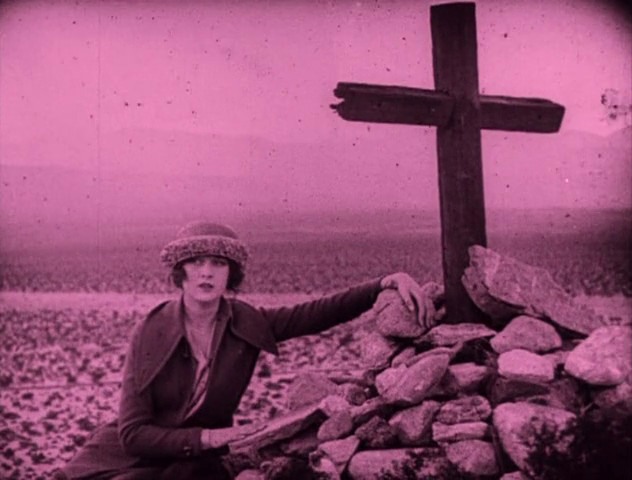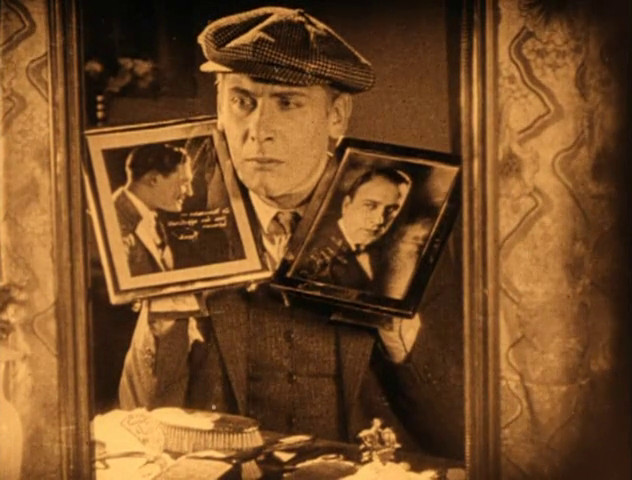Director: Rupert Hughes
Writer: Rupert Hughes, from his own novel
Stars: Eleanor Boardman, Frank Mayo, Richard Dix, Mae Busch, Barbara La Marr, Lew Cody and Thirty-Five Famous Stars
 |
I took this viewing of Souls for Sale as a kind of test. I first saw it on TCM in 2006 and failed to recognise many of the “thirty-five famous stars” that it boasts alongside its leads. I’m far more versed in silent cinema in 2023, so I was eager to see if that would hold true today. To my discredit, it does, but many of these names drifted quickly away from the limelight.
It’s a Hollywood movie all about Hollywood movies, an attempt to defend an industry that had so recently endured so many scandals: the overdose of Olive Thomas, the Fatty Arbuckle trials and the murder of film director William Desmond Taylor. Those three happened in the three years between 1920 and 1922. Novelist Rupert Hughes did what he could to calm the backlash down in his 1922 novel, Souls for Sale, and again in his own adaptation of it in 1923, a large pool of talent lending their names to his cause in a string of cameos.
Of course, it’s a rags to riches tale of a young lady who finds her way to Hollywood, onto the screen and into the hearts of millions. In this take on that cliché, the star was at least played by a nobody, Eleanor Boardman, who had won a contract with Goldwyn Pictures, the G in the future MGM, in a New Faces of 1922 contest.
 |
It seems fair to point out that, as outrageous as the plot gets, her part isn’t devoid of truth, as she did indeed fail her first screen test, only to get hired anyway and become a star, quicker than her fictional counterpart; she did indeed marry a director, albeit King Vidor rather than Frank Claymore; and she’s still remembered a century on, if mostly for her role in The Crowd rather than for this picture.
Of course, there’s a lot more here that gets wildly melodramatic, but this is Hollywood. In this take, she’s not actually travelling there to become a star; she’s a new bride, Remember Steddon, travelling by train to L.A. with Owen Scudder, the husband who swept her off her feet in a whirlwind romance. Fortunately, she has such major jitters that she climbs off the back of the Express when it stops for water, to stumble off into the California desert.
We soon learn that Scudder is a Bluebeard, the male equivalent of a Black Widow, and she is next on his list. That’s why he doesn’t have anyone on the train notified after she vanishes and just hops off and walks away. He’s quickly caught, but he escapes and, for quite a while, we follow his exploits in parallel with hers.
To me, they distracted a little from the main story, which could have done with the time. It seems fair to suggest that Hughes made a firm attempt to cram everything in his novel into the hour and a half running time and it makes the experience more than a little rushed with the many intertitles often getting in the way, as clever as many of them are. More judicious editing would have helped the film massively. Case in point: there’s a brief scene where Mem gets a job at a Desert Inn rather than travel on to Hollywood with the film crew who rescued her in the desert, only to find that it was about to close, so has to follow on anyway. It’s only a minute, but it’s a minute that didn’t need to be there at all.
 |
By the way, that film crew is where the big names start to show up, not that they all were at the time. The sheik on a camel who sees her first is actor Tom Holby, played by actor Frank Mayo, who was a star in the teens, but Richard Dix, that film’s director, Frank Claymore, was not yet the name he’d become, his biggest role in the silents later in 1923 in Cecil B. DeMille’s version of The Ten Commandments. He’d gain an Oscar nomination for 1931’s Cimarron and find a host of successful roles in the thirties and forties. A debuting William Haines appears a long while ahead of fame briefly as Claymore’s assistant director.
Of course, after Mem gets to Hollywood, she quickly bumps into Holby and Claymore and it all begins, both as a love triangle between the three of them and as a nascent career on the big screen. You could easily write much of this yourself, but it’s done with a true knowledge of the industry, even if it’s not always played for accuracy.
For instance, this company’s leading female star is Robina Teele, sweetheart on the screen but bitch off it; while vampish Leva Lemaire, the wickedest woman on the screen, is clearly the nicest person in the world off it. I liked her a lot, and want to see her fictional movies!
A less believable detail is the famous casting couch. Here, casting director Arthur Tirrey is a tired man who has to fend off all the girls who try to vamp him for jobs. It’s a hard life, you know. He’s played by Roy Atwell, famous, if uncredited, as the voice of Doc in Snow White and the Seven Dwarfs.
 |
These inside looks at the business extend to looks in on a string of pictures currently in the process of being shot. There’s Charlie Chaplin, directing A Woman of Paris; Fred Niblo making The Famous Mrs. Fair, a lost picture today; and Erich von Stroheim shooting his epic, Greed. It doesn’t all ring true and I’m sure some of this was staged, but we feel the glamour that Mem must have felt in those rooms.
While I recognised the directors, I was less successful with the stars. Admittedly, some I’d have recognised aren’t in this version, which is slightly incomplete—such as Bessie Love and Anna Q. Nilsson—I only knew a few who are, like ZaSu Pitts. There’s one shot of six stars at a table and audiences of the time would have squeed, but I only knew one, Chester Conklin.
I like this film. It has a lot of character and I felt for Mem as she navigates Hollywood and burgeoning stardom, while having to fend off her two famous suitors because she’s secretly married. She can’t tell them that, because one marriage scandal would end her career, but it comes back to bite her anyway when Scudder shows up—like that wasn’t going to happen?—to cause trouble. It all works out in the end, of course, and we happily go along with it.
What seems odd is how dangerous it seems to be working for this fictional film company. Mem obtains her big break after a huge stage light falls onto Robina Teele’s legs during a take, crippling her. A melodramatic final scene has a circus tent set struck by lightning and catching on fire, with hundreds of people in it. Never mind a defence of Hollywood, this feels like quite the invite to bring in OSHA!






2 comments:
I greatly enjoyed your write-up on this film, Hal -- I was intrigued from the start because I recognized the poster and the name. I sure would like to see it!
Many thanks, Karen, and apologies for not seeing your comment sooner. I believe Souls for Sale is now on YouTube, so, if you haven't caught up with it already, you can do so here:
https://www.youtube.com/watch?v=Dy4M5QDAWfs
Post a Comment